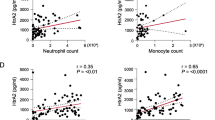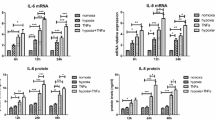Abstract
Fibroblast-like synoviocytes (FLS) play a key role in the genesis of rheumatoid arthritis (RA). FLS are among the most versatile cells with the potential to activate an array of genes that are able to initiate and propagate inflammation in RA-affected joints. Controlling activation of FLS might hold the key to restraining inflammation in RA-affected joints. In this study, we investigate the effect and mechanisms of short-term hyperthermia on a series of proinflammatory genes in FLS. In vitro experiments demonstrate that exposure of FLS to elevated temperatures for the duration of 30 min prevents activation of a series of genes with proinflammatory properties. Exposure to hyperthermia reduces IL-1β-induced prostaglandin E2 release, suppresses activation of the adhesion molecules VCAM-1, ICAM-1, the cytokines TNFα, IL-1α, IL-1β, IL-8 as well as COX-2 protein synthesis. Real time reverse transcriptase-polymerase chain reaction showed that hyperthermia altered gene expression at the transcriptional level. The amount and the duration of inhibition is gene-specific and lasts for up to 25 h. As to the mechanism of inhibition, electrophoretic mobility shift assay experiments demonstrated that exposure of FLS to hyperthermia prevents IL-1β-induced NF-κB translocation and subsequent DNA binding. Many mechanisms have been shown to be involved in hyperthermia-mediated effects on NF-κB-DNA interactions. We demonstrate by Western blot experiments that in FLS, hyperthermia prevents the phosphorylation and subsequent degradation of IκBα, therefore retaining the NF-κB complex in the cytoplasm. Carefully controlled in vivo tests are certainly needed before one can take full advantage of those phenomena; however, the ease by which the temperature in joints can be modulated might offer an opportunity for manipulating inflammatory processes in joints by simple balneological means.







Similar content being viewed by others
References
Tanaka A, O’Sullivan FX, Koopman WJ, Gay S (1988) Etiopathogenesis of rheumatoid arthritis-like disease in MRL/1 mice: II. Ultrastructural basis of joint destruction. J Rheumatol 15:10–16
Geiler T, Kriegsmann J, Keyszer GM, Gay RE, Gay S (1994) A new model for rheumatoid arthritis generated by engraftment of rheumatoid synovial tissue and normal human cartilage into SCID mice. Arthritis Rheum 37:1664–1671
Pap T, Muller-Ladner U, Gay RE, Gay S (2000) Fibroblast biology. Role of synovial fibroblasts in the pathogenesis of rheumatoid arthritis. Arthritis Res 2:361–367
Pap T, Aupperle KR, Gay S, Firestein GS, Gay RE (2001) Invasiveness of synovial fibroblasts is regulated by p53 in the SCID mouse in vivo model of cartilage invasion. Arthritis Rheum 44:676–681
Kriegsmann J, Keyszer GM, Geiler T, Brauer R, Gay RE, Gay S (1995) Expression of vascular cell adhesion molecule-1 mRNA and protein in rheumatoid synovium demonstrated by in situ hybridization and immunohistochemistry. Lab Invest 72:209–214
Seemayer CA, Kuchen S, Kuenzler P, Rihoskova V, Rethage J, Aicher WK et al (2003) Cartilage destruction mediated by synovial fibroblasts does not depend on proliferation in rheumatoid arthritis. Am J Pathol 162:1549–1557
Hutter JJ, Mestril R, Tam EK, Sievers RE, Dillmann WH, Wolfe CL (1996) Overexpression of heat shock protein 72 in transgenic mice decreases infarct size in vivo. Circulation 94:1408–1411
Gowda A, Yang CJ, Asimakis GK, Ruef J, Rastegar S, Runge MS et al (1998) Cardioprotection by local heating: improved myocardial salvage after ischemia and reperfusion. Ann Thorac Surg 65:1241–1247
Villar J, Ribeiro SP, Mullen JB, Kuliszewski M, Post M, Slutsky AS (1994) Induction of the heat shock response reduces mortality rate and organ damage in a sepsis-induced acute lung injury model. Crit Care Med 22:914–921
Redaelli CA, Wagner M, Kulli C, Tian YH, Kubulus D, Mazzucchelli L et al (2001) Hyperthermia-induced HSP expression correlates with improved rat renal isograft viability and survival in kidneys harvested from non-heart-beating donors. Transpl Int 14:351–360
Yoo CG, Lee S, Lee CT, Kim YW, Han SK, Shim YS (2000) Anti-inflammatory effect of heat shock protein induction is related to stabilization of I kappa B alpha through preventing I kappa B kinase activation in respiratory epithelial cells. J Immunol 164:5416–5423
Perdrizet GA (1995) Heat shock and tissue protection. New Horiz 3:312–320
Tytell M, Hooper PL (2001) Heat shock proteins: new keys to the development of cytoprotective therapies. Expert Opin Ther Targets 5:267–287
van Tubergen A, van der Linden S (2002) A brief history of spa therapy. Ann Rheum Dis 61:273–275
Welch V, Brosseau L, Shea B, McGowan J, Wells G, Tugwell P (2001) Thermotherapy for treating rheumatoid arthritis. Cochrane Database Syst Rev CD002826
Lange U, Muller-Ladner U, Schmidt KL (2005) Balneotherapy in rheumatic diseases—an overview of novel and known aspects. Rheumatol Int 1–3
Kavuncu V, Evcik D (2004) Physiotherapy in rheumatoid arthritis. MedGenMed 6:3
Okubo S, Wildner O, Shah MR, Chelliah JC, Hess ML, Kukreja RC (2001) Gene transfer of heat-shock protein 70 reduces infarct size in vivo after ischemia/reperfusion in the rabbit heart. Circulation 103:877–881
Stuhlmeier KM, Pollaschek C (2004) Differential effect of transforming growth factor beta (TGF-beta) on the genes encoding hyaluronan synthases and utilization of the p38 MAPK pathway in TGF-beta-induced hyaluronan synthase 1 activation. J Biol Chem 279:8753–8760
Stuhlmeier KM, Csizmadia V, Cheng Q, Winkler H, Bach FH (1994) Selective inhibition of E-selectin, ICAM-1, and VCAM in endothelial cells. Eur J Immunol 24:2186–2190
Stuhlmeier KM (2005) Effects of leflunomide on hyaluronan synthases (HAS): NF-kappa B-independent suppression of IL-1-induced HAS1 transcription by leflunomide. J Immunol 174:7376–7382
Steeber DA, Tedder TF (2000) Adhesion molecule cascades direct lymphocyte recirculation and leukocyte migration during inflammation. Immunol Res 22:299–317
Kroeger P, Morimoto RI (1995) The heat shock transcriptional response. In: Baeuerle P (ed) Inducible gene expression, environmental stresses and nutrients. Birkhauser, Boston, 25–61
Otterbein LE, Soares MP, Yamashita K, Bach FH (2003) Heme oxygenase-1: unleashing the protective properties of heme. Trends Immunol 24:449–455
Alcaraz MJ, Fernandez P, Guillen MI (2003) Anti-inflammatory actions of the heme oxygenase-1 pathway. Curr Pharm Des 9:2541–2551
Johnson AD (1995) The price of repression. Cell 81:655–658
Scheinman RI, Gualberto A, Jewell CM, Cidlowski JA, Baldwin AS Jr (1995) Characterization of mechanisms involved in transrepression of NF-kappa B by activated glucocorticoid receptors. Mol Cell Biol 15:943–953
Wong HR, Ryan M, Wispe JR (1997) Stress response decreases NF-kappaB nuclear translocation and increases I-kappaBalpha expression in A549 cells. J Clin Invest 99:2423–2428
Siebenlist US, Brown K, Franzoso G (1995) NF-κB: a mediator of pathogen and stress responses. In: Bauerle PA (ed) Inducible gene expression, environmental stresses and nutrients. Birkaeuser, Boston, 93–141
Chen Y, Ross BM, Currie RW (2004) Heat shock treatment protects against angiotensin II-induced hypertension and inflammation in aorta. Cell Stress Chaperones 9:99–107
Chan JY, Ou CC, Wang LL, Chan SH (2004) Heat shock protein 70 confers cardiovascular protection during endotoxemia via inhibition of nuclear factor-kappaB activation and inducible nitric oxide synthase expression in the rostral ventrolateral medulla. Circulation 110:3560–3566
Schell MT, Spitzer AL, Johnson JA, Lee D, Harris HW (2005) Heat shock inhibits NF-κB activation in a dose- and time-dependent manner. J Surg Res 129:90–93
Feinstein DL, Galea E, Aquinao DA, Li GC, Xu H (1996) Heat shock protein70 suppresses astroglial-inducible nitric-oxide synthase expression by decreasing NF-κB activation. J Biol Chem 271:17724–17732
Guzhova IV, Darieva ZA, Melo AR, Margulis BA (1997) Major stress protein Hsp70 interacts with NF-κB regulatory complex in human T-lymphoma cells. Cell Stress Chaperones 2:132–139
Voellmy R (1994) Transduction of the stress signal and mechanisms of transcriptional regulation of heat shock/stress protein gene expression in higher eukaryotes. Crit Rev Eukaryot Gene Expr 4:357–401
Mukaida N, Morita M, Ishikawa Y, Rice N, Okamoto S, Kasahara T et al (1994) Novel mechanism of glucocorticoid-mediated gene repression. J Biol Chem 269:13289–13295
Brostjan C, Anrather J, Csizmadia V, Stroka D, Soares M, Bach FH et al (1996) Glucocorticoid-mediated repression of NF-κB activity in endothelial cells does not involve induction of IκBα synthesis. J Biol Chem 271:19612–19916
Kalkhoven E, Wissink S, van der Saag P, van der Burg B (1996) Negative interaction between the RelA (p65) subunit of NF-κB and the progesterone receptor. J Biol Chem 271:6217–6224
Baeuerle PA, Baltimore D (1996) NF-κB: ten years after. Cell 87:13–20
Abravaya K, Phillips B, Morimoto RI (1991) Attenuation of the heat shock response in HeLa cells is mediated by the release of bound heat shock transcription factor and is modulated by changes in growth and in heat shock temperatures. Genes Dev 5:2117–2127
Bethke K, Staib F, Distler M, Schmitt U, Jonuleit H, Enk AH et al (2002) Different efficiency of heat shock proteins (HSP) to activate human monocytes and dendritic cells: superiority of HSP60. J Immunol 169:6141–6148
Macht LM, Elson CJ, Kirwan JR, Gaston JS, Lamont AG, Thompson JM et al (2000) Relationship between disease severity and responses by blood mononuclear cells from patients with rheumatoid arthritis to human heat-shock protein 60. Immunology 99:208–214
Life P, Hassell A, Williams K, Young S, Bacon P, Southwood T et al (1993) Responses to gram negative enteric bacterial antigens by synovial T cells from patients with juvenile chronic arthritis: recognition of heat shock protein HSP60. J Rheumatol 20:1388–1396
De Graeff-Meeder ER, van der Zee R, Rijkers GT, Schuurman HJ, Kuis W, Bijlsma JW et al (1991) Recognition of human 60 kD heat shock protein by mononuclear cells from patients with juvenile chronic arthritis. Lancet 337:1368–1372
Georgopoulos C, McFarland H (1993) Heat shock proteins in multiple sclerosis and other autoimmune diseases. Immunol Today 14:373–375
Gaston JS (1991) Heat shock proteins and autoimmunity. Semin Immunol 3:35–42
Benjamin IJ, McMillan DR (1998) Stress (heat shock) proteins: molecular chaperones in cardiovascular biology and disease. Circ Res 83:117–132
Xu Q (2002) Role of heat shock proteins in atherosclerosis. Arterioscler Thromb Vasc Biol 22:1547–1559
Acknowledgements
This work was supported in part by grants from the City of Vienna, the Austrian Ministry of Health and Women (236065/008-I/A/Ib/2004), the Austrian Ministry of Education, Science and Culture, and the “Medizinisch-Wissenschaftlicher Fonds des Bürgermeisters der Bundeshauptstadt Wien”. MM is supported by a fellowship of the IFCC. This manuscript is part of the thesis work requirements of MM carried out at the LBI for Rheumatology and Balneology under the supervision of KMS.
Author information
Authors and Affiliations
Corresponding author
Rights and permissions
About this article
Cite this article
Markovic, M., Stuhlmeier, K.M. Short-term hyperthermia prevents activation of proinflammatory genes in fibroblast-like synoviocytes by blocking the activation of the transcription factor NF-κB. J Mol Med 84, 821–832 (2006). https://doi.org/10.1007/s00109-006-0089-6
Received:
Accepted:
Published:
Issue Date:
DOI: https://doi.org/10.1007/s00109-006-0089-6




